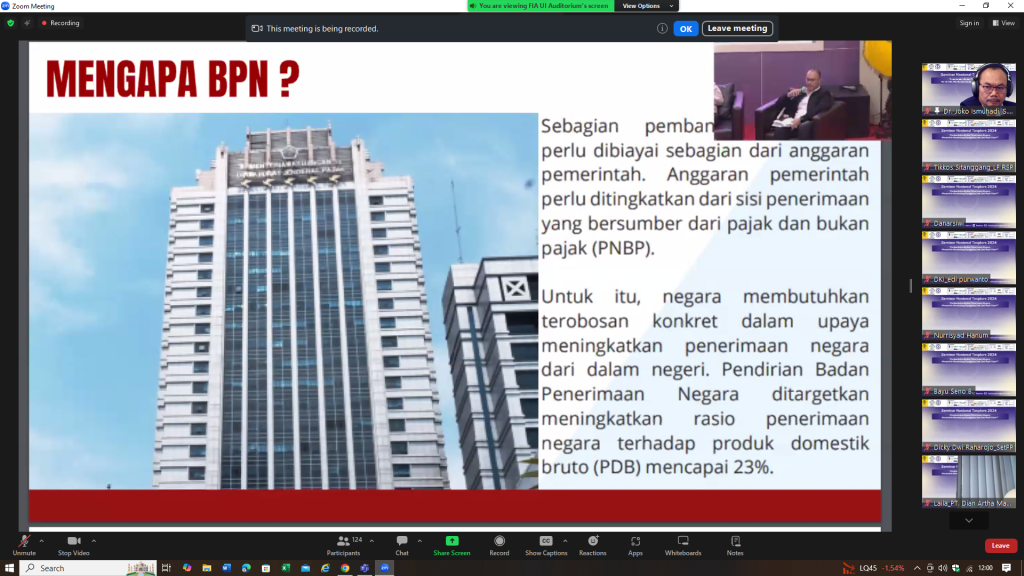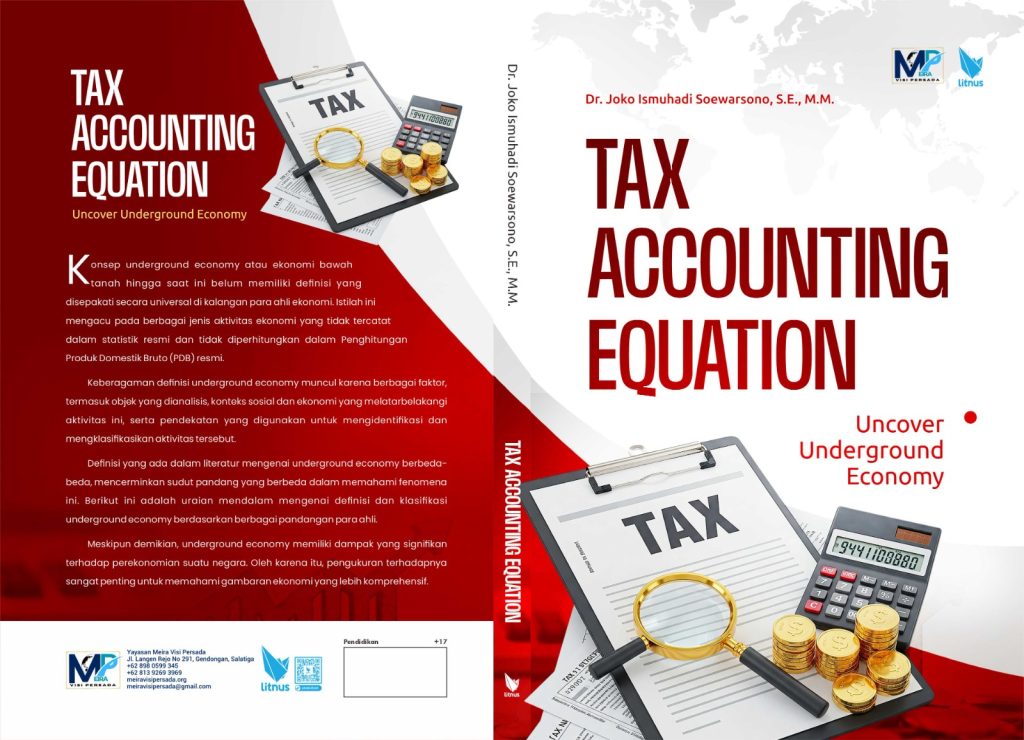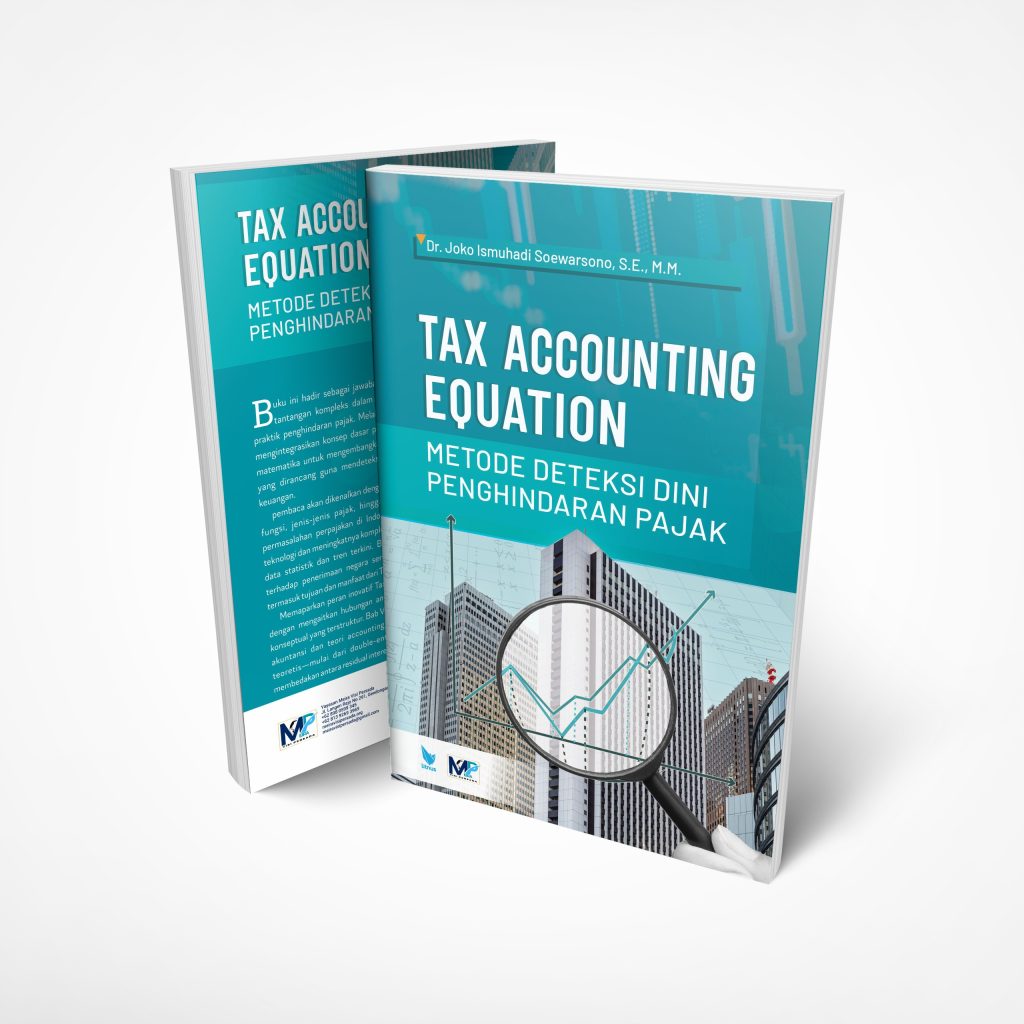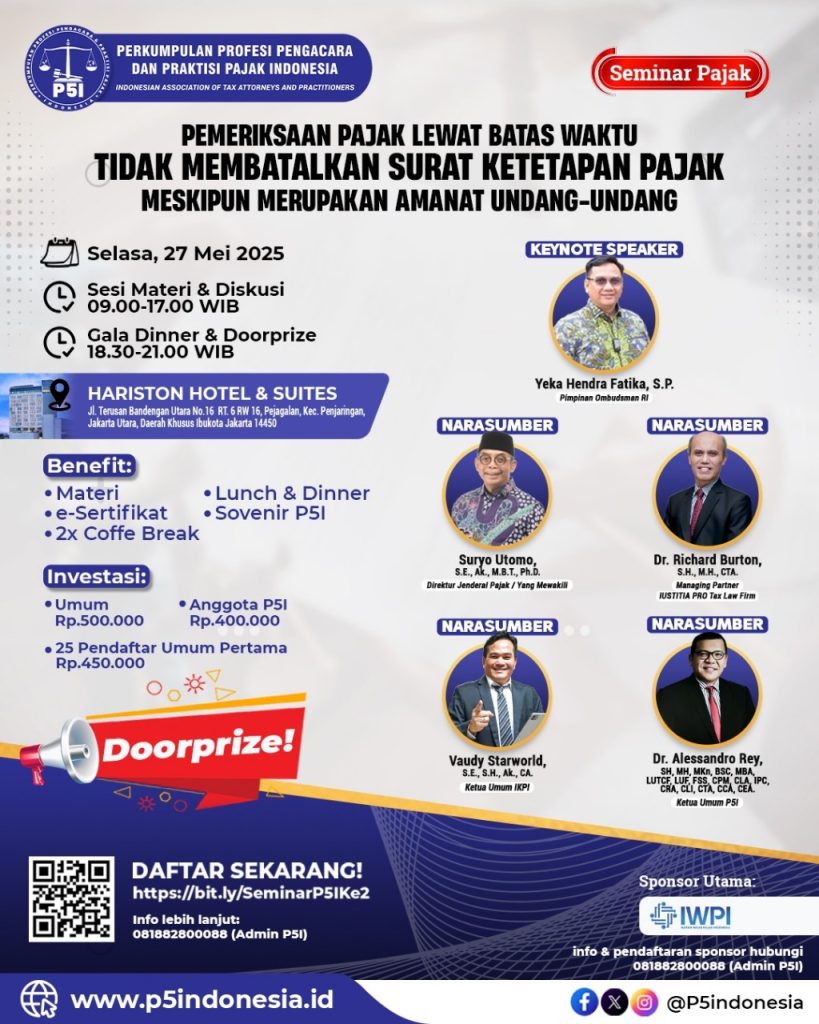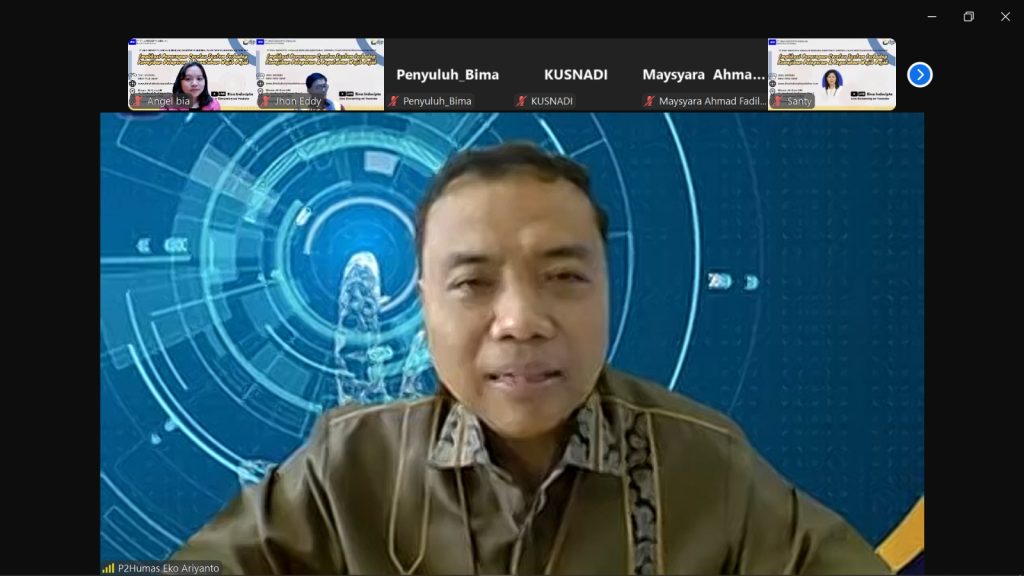
Dr. Joko Ismuhadi’s Tax Accounting Equation: A Forensic Framework for Enhanced Tax Discrepancy Detection and Compliance
- Ekonomi
Wednesday, 04 June 2025 00:22 WIB
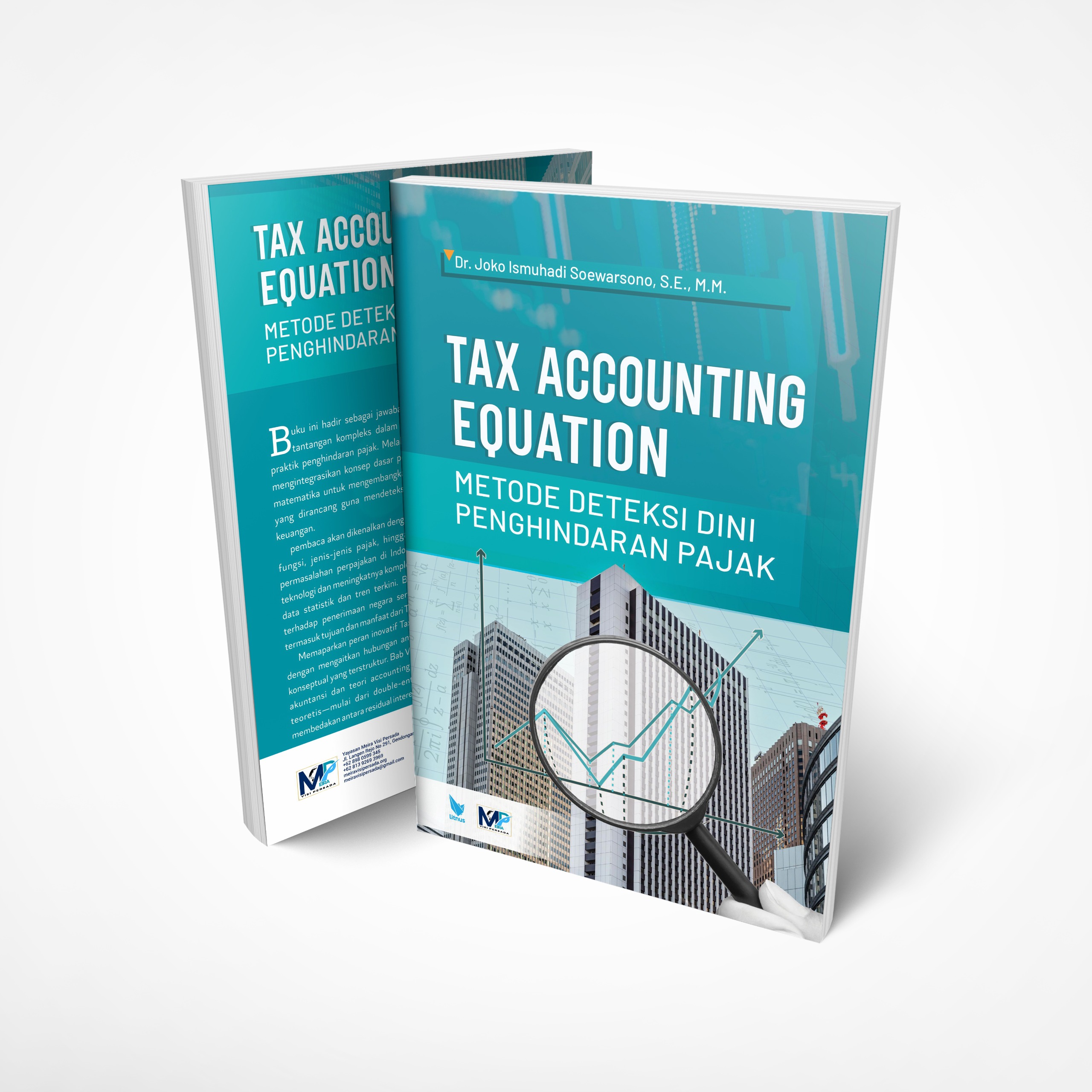
Jakarta, fiskusnews.com:
Executive Summary
This report provides a comprehensive analysis of Dr. Joko Ismuhadi’s Tax Accounting Equation (TAE), an innovative mathematical model designed to significantly enhance the detection of tax discrepancies and irregularities. Developed in response to the inherent limitations of the traditional Basic Accounting Equation (BAE) in uncovering sophisticated tax avoidance schemes, TAE reformulates fundamental financial relationships to provide a more targeted forensic lens. By emphasizing the dynamic interplay between a company’s income statement (Revenue and Expenses) and balance sheet (Assets and Liabilities), TAE offers a proactive framework for identifying anomalous financial reporting patterns indicative of tax manipulation. Its practical applications span internal compliance checks, risk assessment, and significantly improving the efficiency and effectiveness of tax audits, particularly within the Indonesian context where it was conceived to address challenges posed by the underground economy. The integration of TAE into modern tax administration systems holds substantial promise for strengthening tax compliance and fostering greater financial transparency.
Introduction: The Imperative for Advanced Tax Anomaly Detection
2.1. Overview of Dr. Joko Ismuhadi and the Genesis of the Tax Accounting Equation (TAE)
Dr. Joko Ismuhadi Soewarsono is a distinguished Indonesian tax specialist whose contributions are rooted in a unique blend of practical experience and academic rigor. He holds a doctoral background in both tax accounting and tax law, complementing his extensive professional experience as a senior tax auditor and supervisor within the Directorate General of Taxes (DGT) in Jakarta. This distinctive dual perspective allows Dr. Ismuhadi to effectively bridge theoretical accounting and finance concepts with the on-the-ground realities of tax administration in Indonesia. This integrated approach is a testament to how practical challenges can drive academic innovation, ensuring that theoretical models are grounded in real-world problems and that practical solutions are systematically rigorous.
The genesis of the Tax Accounting Equation (TAE) lies in Dr. Ismuhadi’s recognition of the critical need for advanced detection of financial irregularities in tax compliance. He formulated TAE as a direct response to the inherent limitations of the basic accounting equation in effectively detecting sophisticated tax discrepancies. This is particularly pertinent within the Indonesian context, where the underground economy presents a significant challenge by concealing income and evading taxes. The TAE is presented as an innovative mathematical model and an analytical tool specifically designed to enhance both tax detection and planning capabilities. Its primary objective is to facilitate the early detection of potential tax avoidance and/or embezzlement, serving as a specialized framework for forensic tax analysis.
2.2. The Core Challenge: Limitations of the Basic Accounting Equation (BAE) in Tax Scrutiny
The Basic Accounting Equation (BAE), expressed as Assets = Liabilities + Equity, is a fundamental concept underpinning the double-entry accounting system. It represents the equilibrium between a company’s resources (assets) and the sources of its financing, whether through borrowing (liabilities) or owner investments (equity). While universally recognized as the bedrock of financial reporting and essential for verifying bookkeeping accuracy, the BAE possesses several inherent limitations when applied to the nuanced and often deceptive realm of tax discrepancy detection.
The BAE’s over-simplification is a notable constraint; it provides a static snapshot of a company’s financial position at a specific point in time and does not delve into the quality of assets, the urgency of liabilities, or accurately reflect current market values. Crucially, for tax scrutiny, the BAE inherently lacks operational insights because it does not directly capture revenue and expense details. These operational elements are vital for understanding a company’s profitability and economic activity, which are primary drivers of tax liability.
This analytical gap is precisely what TAE aims to bridge. The BAE, while ensuring mechanical accounting balance, often lacks the diagnostic power to reveal why certain financial positions exist or if they are fiscally appropriate. Tax evasion frequently involves manipulating income statement elements (revenue, expenses) or subtly misclassifying balance sheet items to reduce taxable income, which might not immediately disrupt the BAE’s equilibrium. The BAE’s general nature is therefore often “not sufficiently discerning to uncover the often concealed and intricate methods employed in sophisticated tax evasion”. Tax evasion often involves misclassification or concealment of economic activities that might not significantly imbalance the basic equation, making it an inadequate tool for targeted tax scrutiny. Furthermore, the BAE offers no inherent mechanism for risk assessment. This necessitates a specialized, tax-centric analytical framework like TAE, which looks beyond mere balance to the nature and intent of transactions from a tax perspective.
Theoretical Foundations and Derivation of the Tax Accounting Equation (TAE)
3.1. From Basic to Expanded Accounting Equation: The Conceptual Leap
The conceptual foundation for Dr. Joko Ismuhadi’s Tax Accounting Equation (TAE) begins with the universally accepted Basic Accounting Equation (BAE): Assets = Liabilities + Equity. This equation serves as the fundamental representation of a company’s financial structure, illustrating that all assets are financed either by liabilities (debt) or equity (owner’s claims).
To bridge the gap between this static balance sheet view and the dynamic operational activities of a business, the BAE is conceptually expanded into the Expanded Accounting Equation (EAE). This expansion incorporates elements that reflect changes in company value over a period, such as revenues, expenses, and dividends. A common form of the EAE is: Assets = Liabilities + Equity +. This formulation introduces the concept that a company’s net income (Revenues minus Expenses) and dividend distributions directly impact its equity, thus connecting the income statement to the balance sheet.
Building upon this expanded framework, Dr. Ismuhadi further rationalized the Mathematical Accounting Equation (MAE), expressed as: Assets + Dividend + Expenses = Liabilities + Equity + Revenues. The MAE is specifically designed for taxation analysis, particularly in scenarios where taxable income (net income after fiscal correction) is assumed to be zero or negative. Under such conditions, additional retained earnings and dividends are also considered zero, allowing for a focused analysis on potential manipulations that affect these components. This specific formulation provides a more granular and comprehensive framework to detect tax avoidance when the primary method isn’t just understating revenue or overstating expenses. It addresses situations where sophisticated schemes might involve retained earnings, dividends, or other balance sheet manipulations that do not directly impact the income statement in the same way, demonstrating a deeper level of forensic capability beyond the initial TAE forms.
3.2. Detailed Analysis of TAE Formulations
Dr. Ismuhadi formulated the TAE in two interrelated forms, each providing a distinct lens for tax analysis, particularly under the assumption of zero or negative taxable income for detection purposes. These formulations strategically rearrange the basic accounting equation, placing a deliberate emphasis on revenue as a critical indicator of a company’s economic activity and its consequent tax obligations.
- Form 1: Revenue – Expenses = Assets – Liabilities
- This formulation directly links the core components of the income statement (Revenue minus Expenses, representing profitability) with the core components of the balance sheet (Assets minus Liabilities, which fundamentally equals Equity or Net Worth). It establishes a direct mathematical relationship between a company’s operational performance and its financial position.
- The underlying principle here is the “equilibrium of economic activity.” This form of TAE is not merely an algebraic rearrangement; it embodies a fundamental economic principle crucial for tax assessment. It posits that a company’s reported operational performance (profitability) must logically correspond with the changes in its underlying financial structure (net worth). If a company is genuinely profitable, that profitability should manifest as an increase in its net assets or a decrease in its net liabilities.
- This equation establishes an “expected equilibrium” between operational results and financial position from a tax perspective. Significant deviations from this equilibrium serve as strong indicators that reported operational results (e.g., unusually low revenue or disproportionately high expenses) are not genuinely impacting the company’s net worth in a consistent manner. For instance, if a company reports minimal profit (Revenue – Expenses is low) but its Assets – Liabilities (Equity) is growing substantially, it suggests potential underreporting of revenue or overstatement of expenses that are not genuinely impacting the company’s net worth in a corresponding manner. This provides a powerful quantitative check for financial statement manipulation aimed at tax avoidance.
- Form 2: Revenue = Expenses + Assets – Liabilities
- This alternative expression of the TAE (which can also be written as Revenue = Expenses + Equity) highlights a crucial inverse relationship between Revenues and Liabilities: a decrease in Revenues should logically correspond with an increase in Liabilities, and vice versa. This form is particularly useful for detecting deliberate misleading accounting transactions, a common tactic in tax avoidance.
- This formulation is specifically designed to unmask misclassification as a tax avoidance tactic. Taxpayers might intentionally record revenue as a liability (e.g., “unearned revenue” for services already rendered) or an expense as an asset (e.g., inflating inventory values) to directly reduce reported taxable income, while potentially keeping the balance sheet mechanically balanced under the BAE.
- By isolating Revenue on one side and linking it to Expenses and the net balance sheet position (Assets – Liabilities), this form makes such misclassifications mathematically apparent. For example, if revenue is improperly recorded as a liability, it would reduce the reported current income, thereby lowering tax liability. Conversely, if an expense is improperly capitalized as an asset, it would reduce current expenses, inflating reported profit. However, when viewed through the lens of this TAE form, such deceptive entries would create an imbalance, acting as a direct mathematical red flag for these specific manipulative practices. This provides a precise audit target for tax authorities.
Table 1: Comparison of Basic Accounting Equation and Tax Accounting Equation (TAE)
| Feature | Basic Accounting Equation (BAE) | Tax Accounting Equation (TAE) | | :— | :— |:— | | Formula | Assets = Liabilities + Equity | Revenue – Expenses = Assets – Liabilities; Revenue = Expenses + Assets – Liabilities | | Emphasis/Focus | Financial Position | Profitability and its relation to Net Worth, Revenue as key indicator | | Primary Use | General Financial Reporting | Forensic Tax Analysis, Early Detection of Tax Irregularities |
3.3. The Mathematical Accounting Equation (MAE) for Specific Tax Scenarios
Beyond the two primary TAE forms, Dr. Ismuhadi also formulated the Mathematical Accounting Equation (MAE) as: Assets + Dividend + Expenses = Liabilities + Equity + Revenues. This equation represents a complementary tool designed to address complex tax avoidance beyond simple income manipulation.
The existence of MAE suggests that Dr. Ismuhadi recognized that tax avoidance strategies can be highly complex and extend beyond straightforward adjustments to revenue and expenses. More sophisticated schemes might involve the strategic manipulation of retained earnings, dividend distributions, or other balance sheet components that do not directly or immediately impact the income statement in a way that the primary TAE forms would immediately flag.
MAE provides a more granular and comprehensive framework to detect tax avoidance when the primary method isn’t just understating revenue or overstating expenses. By explicitly incorporating dividends and equity alongside assets, liabilities, revenues, and expenses, MAE allows for the detection of manipulations that aim to reduce taxable income by affecting retained earnings or dividend distributions, especially when taxable income is reported as zero or negative. This demonstrates a deeper level of forensic capability, targeting more intricate financial engineering tactics that might otherwise be overlooked by less comprehensive analytical tools.
Unique Features and Advantages of TAE in Combating Tax Avoidance
4.1. Targeting Underreported Income and Misclassified Transactions
The Tax Accounting Equation is specifically engineered as an analytical tool for the meticulous examination of taxpayer financial statements, with the explicit purpose of identifying early tendencies toward tax avoidance and/or embezzlement. It empowers tax officers to discern discrepancies and unusual patterns within financial reports that strongly indicate intentional misreporting for tax purposes.
A key advantage of TAE is its ability to move from symptom to root cause detection. Traditional audits might identify low reported profits as a symptom of potential tax avoidance, but they may not immediately reveal how that low profit was achieved. TAE goes deeper by providing a mathematical framework to quantify the discrepancy between reported operational results and the company’s financial position. Specifically, TAE is highly effective in flagging instances where revenues might be deliberately understated or expenses overstated, as these manipulations would create a discernible imbalance within the TAE when compared to the corresponding asset and liability figures on the balance sheet, signaling potential tax evasion. This capability allows tax authorities to shift from merely verifying reported numbers to actively identifying the mechanisms through which reported income is manipulated. For example, if TAE reveals a significant disconnect between a company’s reported revenue and the growth in its assets or changes in its liabilities, it directly points to potential underreporting of income or misclassification of transactions. This fundamentally changes the audit focus from a broad review to a targeted investigation of the underlying economic reality reflected by the interrelationships of financial statements, making detection more efficient and effective.
4.2. Detection of Deceptive Practices: The Role of “Clearing Accounts”
A significant and unique advantage of TAE lies in its instrumental role in identifying potentially misleading accounting transactions, such as the deliberate recording of revenues as liabilities or expenses as assets. This capability allows TAE to pinpoint specific fraudulent methodologies.
The explicit identification of “clearing accounts” as a target of TAE is a critical detail. These are temporary accounts that are typically expected to have a zero balance at the end of an accounting period, usually monthly, but can be misused to temporarily misrepresent financial flows. For example, a company might temporarily record revenue as an unearned liability to defer its recognition and associated tax burden. Similarly, expenses could be misclassified as assets to inflate financial position while reducing current period taxable income.
The research indicates that banking services, such as Cash Management Service with Bank Overdraft Account facilities, can be exploited to serve as clearing accounts. These accounts might be used to finance company operations while awaiting down payments from buyers or subsequent companies in a business chain, allowing for the temporary misclassification of funds. By highlighting these unusual inverse relationships (e.g., revenue being temporarily recorded as a liability), TAE functions as a precise “red flag,” directing tax authorities to conduct more in-depth investigations into these specific accounts and transactions. This demonstrates TAE’s advanced forensic capability to uncover hidden transactions and expose financial manipulation that might otherwise be obscured within the complexities of a company’s general ledger. The case study involving CPO (Crude Palm Oil) industry group corporate taxpayers in Indonesia, who for five consecutive years reported overpayment of corporate income tax returns and monthly overpaid value-added tax returns, along with requests for restitution, exemplifies the type of persistent and subtle manipulation that TAE is designed to bring to light.
4.3. Enhanced Analysis of Group Company Financial Engineering
TAE proves particularly relevant and effective in analyzing complex transactions occurring within group companies, especially those with integrated upstream to downstream operations. This capability addresses the challenge of intercompany profit shifting and complex structures.
Corporate groups often engage in highly intricate financial engineering activities that are sometimes strategically designed to shift profits between entities or inflate costs in specific jurisdictions to minimize the overall tax liability of the consolidated group. Without a comprehensive analytical tool, traditional single-entity audits often struggle to gain a full, systemic view of such orchestrated schemes across multiple legal entities.
By applying the TAE to the financial statements of these related entities, tax authorities can uncover such potentially tax-avoidant transactions that might be disguised through complex intercompany dealings. TAE’s ability to analyze the equilibrium between operational results and financial position across related entities provides a systemic view that transcends individual company boundaries. Discrepancies in the TAE for a single group entity, or inconsistencies that emerge when comparing the TAE relationships across various related entities, can indicate orchestrated profit shifting or cost inflation designed to minimize overall tax liability. This extends TAE’s utility beyond basic single-entity analysis to more complex corporate structures, which are common vehicles for aggressive tax planning and avoidance.
4.4. Contribution to Uncovering the Underground Economy
A significant and explicit objective of TAE is to uncover Underground Economy Activity (UEA), which represents a substantial challenge to governments worldwide, particularly in developing economies like Indonesia. Estimates suggest that the underground economy can constitute a significant portion of Indonesia’s Gross Domestic Product (GDP), potentially ranging from 30-40%, by evading taxation and distorting macroeconomic indicators.
TAE offers a novel approach to quantifying and targeting this shadow economy. By systematically identifying discrepancies between reported financial data and expected tax obligations, TAE provides valuable insights into the scale and nature of hidden economic activity. The underground economy is inherently elusive, making its measurement and taxation notoriously difficult. TAE’s focus on fundamental financial relationships provides a quantitative and inferential lens to estimate the existence and potential scale of such unreported activities.
For instance, if a company’s reported revenue is demonstrably insufficient to support its reported expenses and observed asset growth, this incongruity could strongly indicate the presence of unreported income derived from hidden economic activities. TAE’s deliberate emphasis on revenue as a key indicator of economic activity allows tax authorities to scrutinize the logical alignment between a company’s reported income and its other financial elements. When this alignment is significantly distorted, it strongly suggests that economic activity is occurring but is not being fully reported for tax purposes, thus contributing to the underground economy. This provides a novel, equation-based approach to a persistent and significant challenge for tax authorities in countries like Indonesia, with the potential to lead to an expanded tax base and increased government revenue.
Practical Applications and Integration into Tax Administration and Compliance
5.1. TAE as a Forensic Accounting Tool in Tax Audits
The Tax Accounting Equation serves as a valuable analytical tool for tax authorities in their examination of taxpayer financial statements. It facilitates a more sophisticated, forensic, and data-driven approach to combating tax evasion, representing a significant evolution beyond traditional qualitative assessments towards a quantitative methodology.
This capability allows for a shift from reactive to proactive audit triggers. Traditional tax audits often operate reactively, triggered by specific complaints, random selections, or broad industry benchmarks. This can lead to inefficient resource allocation. TAE’s analytical output, however, provides a systematic, data-driven mechanism for proactively identifying high-risk cases. The structured, mathematical nature of TAE enables a more objective and systematic analysis, increasing the likelihood of uncovering instances of tax avoidance and embezzlement that might be missed by conventional, less integrated audit methods. Instead of merely reacting to reported discrepancies or conducting generalized checks, TAE allows auditors to proactively identify “red flags” and unusual patterns in financial statements through its inherent equilibrium checks. This shifts the audit paradigm from broad, less targeted investigations to focused inquiries based on the equation’s analysis, leading to a more efficient allocation of scarce audit resources and maximizing the potential for uncovering tax fraud. This proactive approach enhances the overall effectiveness of tax enforcement.
5.2. Integration within Self-Assessment Monitoring Systems (SAMS)
The integration of Dr. Ismuhadi’s Tax Accounting Equation into a Self-Assessment Monitoring System (SAMS) presents a promising synergy for bolstering tax compliance. This offers a powerful, proactive approach to managing tax obligations and mitigating risks, particularly relevant within the Indonesian context where a self-assessment system has been in place since 1983.
This integration empowers taxpayers for proactive compliance. Indonesia’s reliance on a self-assessment tax system places a significant onus on taxpayers to accurately report and remit their liabilities. TAE’s integration into SAMS transforms it from solely a government audit tool into a powerful internal control mechanism for businesses. Organizations can leverage TAE as a routine internal check on their financial data, enabling the early identification of unusual fluctuations or discrepancies before they escalate into significant tax issues. This reduces the likelihood of both unintentional errors and intentional misstatements, thereby strengthening the integrity of the self-assessment process. It shifts compliance from a reactive response to external audits into an embedded objective of operational excellence, potentially leading to reduced penalties and an improved overall tax posture.
Practical applications of TAE within a SAMS include:
- Internal Compliance Checks: Using TAE as a continuous internal mechanism to identify inconsistencies, such as a sudden increase in assets without a corresponding increase in revenue or decrease in liabilities, which could indicate underreporting of income or misclassification of transactions.
- Risk Assessment: Deviations from the expected TAE balances can serve as early warning indicators of potential tax risks. Establishing acceptable ranges for the TAE relationship allows significant variances to trigger internal alerts, prompting further investigation and corrective action.
- Data Quality Assurance: Imbalances point to errors in recording, enhancing data reliability for tax reporting.
- Educational Tool: Fostering a culture of tax awareness and compliance among finance and accounting teams.
- Automation within Internal Systems: The logical framework of TAE can be programmed into a company’s existing accounting software or data analytics platforms, enabling continuous and efficient self-assessment. This provides real-time alerts for deviations, facilitating immediate intervention.
- Supporting Documentation for External Audits: Consistent and documented use of TAE for internal self-assessment builds a robust audit trail. This demonstrates a proactive commitment to tax compliance and transparency, which can potentially streamline external audit processes and reduce audit scrutiny.
The current absence of specific “off-the-shelf” TAE-integrated SAMS software also highlights a significant market opportunity for accounting technology developers.
5.3. Improving Audit Efficiency and Risk Prioritization for Tax Authorities
TAE significantly enhances audit efficiency by enabling tax auditors to strategically focus their limited resources on cases that are identified as high-risk based on the equation’s analytical output. This capability directly supports optimizing scarce audit resources.
Tax authorities globally, including Indonesia’s DGT, operate with finite resources relative to the vast number of taxpayers. Without precise targeting tools, audits can be broad, time-consuming, and yield diminishing returns. TAE offers a quantitative method to pinpoint high-probability targets. This targeted approach to risk assessment maximizes the potential for uncovering tax fraud and irregularities, leading to a more impactful and cost-effective enforcement strategy. By providing a quantitative, early warning system, TAE allows the Directorate General of Taxes (DGT) to prioritize audits and investigations more effectively. Instead of conducting less targeted audits, resources can be concentrated on entities exhibiting significant deviations from the TAE’s expected equilibrium, as these are statistically more likely to harbor irregularities. This leads to a higher return on audit investment and a more impactful enforcement strategy, ultimately contributing to increased state revenue.
5.4. Relevance and Application within the Indonesian Tax Landscape
The Tax Accounting Equation is particularly relevant and specifically designed for the Indonesian financial and regulatory landscape. This localized innovation for local challenges is a critical aspect of TAE’s potential impact.
Its development by an Indonesian tax expert, Dr. Joko Ismuhadi, inherently takes into account the specific challenges and characteristics of the Indonesian economy, including the prevalence of the underground economy and various common tax evasion tactics. Dr. Ismuhadi’s deep understanding of the Indonesian tax system, likely informed by his extensive experience within the tax authority, has been instrumental in developing an equation that targets specific financial reporting patterns and manipulations commonly observed in Indonesia.
The high prevalence of the underground economy in Indonesia (estimated at 30-40% of GDP ) and specific manipulation patterns (e.g., the misuse of clearing accounts ) necessitate a tailored approach. TAE’s contextualized design ensures it directly addresses these local challenges, making it a highly effective tool for Indonesian tax authorities. The potential adoption of TAE by the Directorate General of Taxes (DJP) aligns seamlessly with Indonesia’s ongoing tax reforms, which aim to improve tax compliance, increase state revenue, and leverage technology for enhanced tax administration. This localized innovation increases the likelihood of successful implementation and significant impact on tax revenue and fairness within the country.
Table 2: Key Applications of the Tax Accounting Equation (TAE) in Practice
| Application Area | Description/Benefit |
|---|---|
| Internal Compliance Checks | Proactively identifies unusual fluctuations or discrepancies in financial data, signaling potential income underreporting or misclassification. |
| Risk Assessment | Deviations from expected TAE balances serve as early warning indicators, triggering alerts for further investigation and corrective action. |
| Data Quality Assurance | Imbalances point to errors in recording revenue, expenses, assets, or liabilities, thereby enhancing data reliability for tax reporting. |
| Educational Tool | Fosters a culture of tax awareness and compliance among finance and accounting teams by illustrating interconnectedness of financial statements. |
| Automation within Internal Systems | TAE logic can be programmed into accounting software for continuous, real-time self-assessment, providing immediate alerts for deviations. |
| Supporting Documentation for External Audits | Consistent use builds a stronger audit trail, demonstrating commitment to tax compliance and potentially streamlining external audit processes. |
| Detection of Underreported Income/Misclassified Transactions | Identifies deliberate understatement of revenues or overstatement of expenses, and misclassification of income as liabilities or expenses as assets. |
| Uncovering Hidden Economic Activity | Provides insights into the scale and nature of the underground economy by flagging inconsistencies between reported data and expected economic activity. |
| Analysis of Group Company Financial Engineering | Helps uncover profit shifting or cost inflation within integrated group companies designed to minimize overall tax liability. |
Comparative Analysis and Future Outlook
6.1. TAE vs. Traditional Audit Methods and Other Detection Techniques
The Tax Accounting Equation offers a distinct and complementary approach when compared to traditional audit methodologies and other advanced tax avoidance detection techniques.
- Traditional Audit Methods: Traditional tax audit techniques employed by tax authorities typically include direct methods, such as the examination of books, records, and specific documents, and indirect methods, which utilize approaches like the cash transaction and bank deposit method to assess the reasonableness of reported income. While these foundational methods are indispensable, TAE provides a more specific, mathematically derived, equation-based approach that complements them by focusing on fundamental relationships between key financial variables. This means that while traditional methods verify individual transactions or aggregate cash flows, TAE provides a holistic, systemic check on the consistency of a company’s financial statements from a tax perspective.
- Other Detection Techniques:
- Effective Tax Rates (ETRs) and Book-Tax Differences (BTDs): Effective Tax Rates (ETRs) and Book-Tax Differences (BTDs) are common measures used to assess tax avoidance by comparing a company’s accounting profit to its taxable profit. While these measures provide an aggregate view of the extent of tax avoidance, TAE offers a different lens. It focuses on the equilibrium between income statement and balance sheet elements, rather than just the overall tax rate or differences between book and tax income. TAE can detect “conforming tax avoidance” , where tax strategies reduce both book and tax income, which might not be as readily captured by ETR or BTD measures that primarily focus on non-conforming differences. TAE’s strength lies in its ability to detect specific types of financial manipulations (e.g., clearing accounts, misclassification) that might be obscured or simply not the primary focus of other methods. While ETRs and BTDs provide an aggregate view of tax avoidance, TAE offers a diagnostic tool to identify how that avoidance is being achieved at the transactional level.
- Financial Ratios: Financial ratios, such as current asset turnover or noncurrent liabilities ratio, are also used as indicators of corporate tax avoidance. However, TAE offers a holistic equation-based approach that integrates multiple financial statement components simultaneously, providing a more comprehensive view than individual ratios. This allows for a more integrated analysis of financial health in relation to tax compliance.
- Advanced Data Analytics (ANN, Machine Learning): Emerging technologies like Artificial Neural Networks (ANN) and machine learning algorithms are increasingly explored for tax evasion detection, analyzing large datasets to identify patterns and anomalies. TAE complements these technologies by providing a targeted, theoretical framework that can guide and interpret the findings from broader data analysis. This suggests a future where human expertise (embodied in TAE’s logic) and computational power combine for superior detection, moving beyond simple pattern recognition to understanding the underlying financial relationships and identifying specific irregularities that might be missed by purely statistical models.
6.2. Academic and Professional Reception of TAE
The Tax Accounting Equation has garnered significant attention and sparked discussions within both academic and professional circles, particularly in Indonesia. This broad acceptance suggests TAE’s perceived value and potential.
Public discourse surrounding TAE, notably on platforms like YouTube, highlights its potential to modernize traditional accounting methodologies and effectively address tax evasion challenges in Indonesia. Publications consistently emphasize TAE’s utility as a forensic accounting tool specifically tailored for the Indonesian context, with consistent media coverage underscoring its perceived significance and novelty.
Dr. Ismuhadi’s active engagement with the Directorate General of Taxes (DJP) and his presentations at academic seminars clearly indicate that his research is being seriously considered by both tax practitioners and scholars. His role as an academic member of key tax and legal expert associations in Indonesia further solidifies this professional and academic validation. The widespread discussion and consideration by both academic and professional bodies validate TAE’s theoretical soundness and practical utility. This reception is crucial for its eventual widespread adoption and integration into national tax policies and audit practices, demonstrating a consensus on its potential to address significant tax challenges in Indonesia.
6.3. Potential for Broader Adoption and Policy Implications
The potential for broader adoption of the Tax Accounting Equation, particularly within Indonesia, is substantial and aligns with ongoing national tax reform initiatives.
There is a strong possibility that Dr. Ismuhadi’s research and the TAE could be formally considered for adoption or to significantly influence internal practices within the Directorate General of Taxes (DGT). This is largely attributable to Dr. Ismuhadi’s direct experience as a tax auditor within the DGT, which provides a practical context that makes his proposed solutions highly relevant and potentially implementable within the existing framework.
The alignment of TAE with Indonesia’s ongoing tax reforms is a critical factor. These reforms are aimed at improving tax compliance, increasing state revenue, and effectively addressing issues such as the underground economy through enhanced tax administration and the strategic leverage of technology. The adoption of TAE by a national tax authority like Indonesia’s DGT would signify a systemic shift in tax enforcement strategy. TAE’s ability to enhance audit efficiency and quantitatively uncover hidden economic activity directly supports national goals of increasing tax revenue and fostering a more equitable tax system. This indicates its potential to be a cornerstone of a modernized, data-driven tax administration.
Furthermore, discussions surrounding TAE highlight its relevance for other countries facing similar challenges with tax evasion and a large informal economy. This suggests that TAE could serve as a model for other developing economies grappling with similar tax compliance issues and substantial informal sectors, potentially leading to its broader international applicability and impact.
7. Conclusion and Recommendations
7.1. Conclusion
Dr. Joko Ismuhadi’s Tax Accounting Equation (TAE) represents a significant advancement in forensic tax accounting, offering a sophisticated and targeted framework for the early detection of tax discrepancies and irregularities. It was meticulously developed to overcome the inherent limitations of the Basic Accounting Equation (BAE), which, while fundamental for general financial reporting, lacks the specificity required to uncover complex tax avoidance schemes. By strategically linking a company’s income statement (Revenue and Expenses) with its balance sheet (Assets and Liabilities), TAE provides a dynamic, tax-centric lens that reveals inconsistencies indicative of financial manipulation.
The core strength of TAE lies in its ability to identify specific deceptive practices, such as the deliberate understatement of income, overstatement of expenses, and the misclassification of revenues as liabilities or expenses as assets, often facilitated by the misuse of “clearing accounts.” Its utility extends to enhancing the analysis of complex financial engineering within group companies and, crucially, provides a quantitative methodology for uncovering hidden economic activity within the underground economy, a pervasive challenge in Indonesia.
TAE’s particular relevance and proven potential within the Indonesian tax landscape are underscored by its development by Dr. Ismuhadi, whose unique blend of academic rigor and practical experience as a tax auditor has ensured its direct applicability to the country’s specific tax challenges. The growing academic and professional reception, coupled with its alignment with Indonesia’s ongoing tax reforms, positions TAE as a vital step towards a more sophisticated, proactive, and data-driven approach to tax administration and compliance. It is not merely a supplementary tool but a foundational element that can integrate with and enhance existing audit methodologies and advanced analytical techniques.
7.2. Recommendations
Based on the comprehensive analysis of Dr. Joko Ismuhadi’s Tax Accounting Equation and its demonstrated capabilities, the following recommendations are put forth for key stakeholders:
- For the Directorate General of Taxes (DGT) in Indonesia:
- Formal Integration: It is strongly recommended to expedite the formal adoption and integration of TAE into the Core Tax Administration System (CTAS) and routine audit methodologies. Leveraging TAE’s forensic capabilities for systematic risk assessment and audit prioritization will significantly enhance the DGT’s enforcement effectiveness.
- Automated Implementation: Investment in developing or acquiring automated tools and software is crucial. These systems should be capable of applying TAE to large datasets of taxpayer financial statements, providing real-time alerts for potential irregularities and streamlining the detection process.
- Training and Capacity Building: Comprehensive training programs should be established for tax auditors and forensic accountants. These programs must cover the theoretical foundations, practical application, and nuanced interpretation of TAE results to build the necessary expertise within the DGT.
- Case Study Development and Dissemination: The DGT should actively conduct and publish detailed case studies on the successful application of TAE in uncovering tax avoidance. Focusing on high-risk sectors, such as the CPO industry highlighted in Dr. Ismuhadi’s research, would demonstrate its practical impact and serve as valuable internal and external educational material.
- Continued Collaboration with Academia: Sustained and deepened collaboration with academic institutions and experts like Dr. Ismuhadi is vital to continuously refine TAE, explore its application to emerging tax avoidance schemes, and ensure its adaptability to evolving economic landscapes.
- For Businesses and Organizations (especially in Indonesia):
- Internal Self-Assessment Implementation: Businesses should proactively integrate TAE as a core component of their internal Self-Assessment Monitoring Systems (SAMS). This will enable organizations to identify and mitigate tax risks internally, improve the accuracy and consistency of their financial data, and foster a robust culture of tax compliance.
- Proactive Risk Management: Utilizing deviations from TAE’s expected equilibrium as early warning indicators should be institutionalized. This will prompt timely internal investigations and corrective actions, thereby reducing the likelihood of penalties and significantly enhancing the organization’s overall tax compliance posture.
- For International Tax Authorities and Researchers:
- Exploration of Adaptability: International tax authorities and research bodies are encouraged to investigate the adaptability and relevance of TAE to other national tax systems. This is particularly pertinent for economies facing similar challenges with widespread tax evasion and large informal sectors, where TAE could offer a valuable, transferable framework.
- Further Academic Research: Continued academic inquiry into TAE’s effectiveness, comparative studies with other tax avoidance detection methods (e.g., ETRs, BTDs), and its potential evolution to address new forms of financial engineering and cross-border tax avoidance is highly recommended to advance the field of forensic tax accounting.
Reporter: Marshanda Gita – Pertapsi Muda
Share
Berita Lainnya
Analisis Kelayakan dan Implikasi Pajak Kekayaan Komprehensif di Indonesia
Analysis of the Tax Accounting Equation’s Potential to Address Income Tax Loopholes in Indonesia
PENGUMUMAN RESMI REUNI PRODIP PAJAK 88 – SURABAYA 2025
Kepala KPP Wajib Pajak Besar Empat menyampaikan Selamat Hari Raya Idul Fitri
Sinergi Sektor Keuangan Negara dan Kesehatan Pilar Penting bagi Indonesia
Mengungkap Ekonomi Tersembunyi: Pendekatan Inovatif Dr. Joko Ismuhadi dalam Mendeteksi Penghindaran Pajak di Indonesia
RAMADHAN HARI KE-12
Rekomendasi untuk Anda

Berita Terbaru
Eksplor lebih dalam berita dan program khas fiskusnews.com
Tag Terpopuler
# #TAE
# #TAX ACCOUNTING EQUATION
# #TAX FRAUD
# #TAX EVASION






